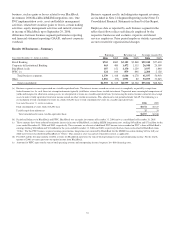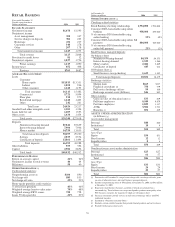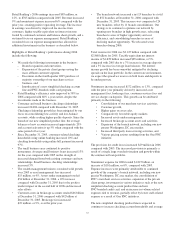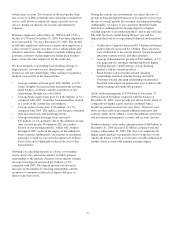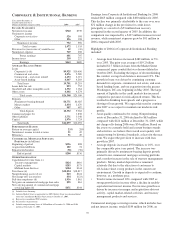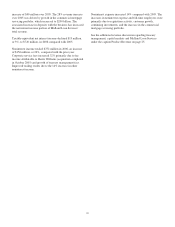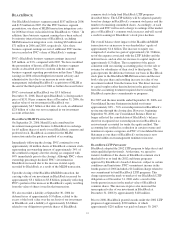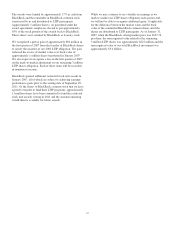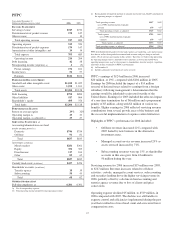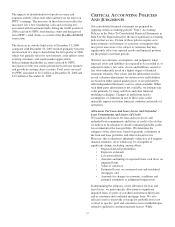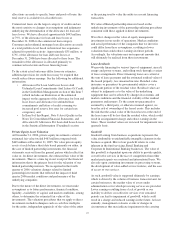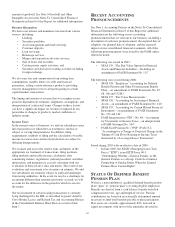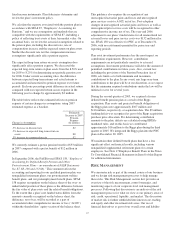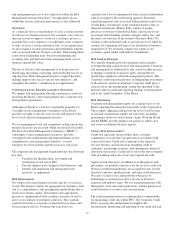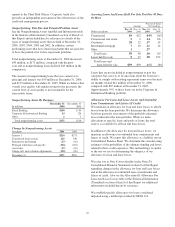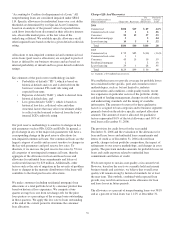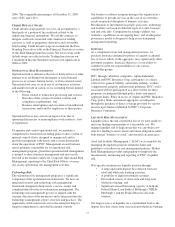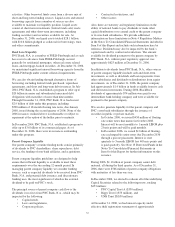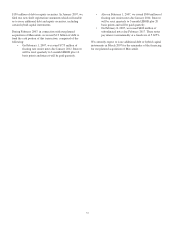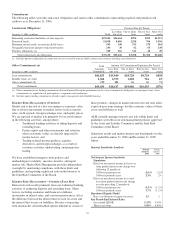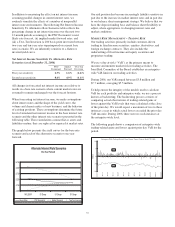PNC Bank 2006 Annual Report Download - page 55
Download and view the complete annual report
Please find page 55 of the 2006 PNC Bank annual report below. You can navigate through the pages in the report by either clicking on the pages listed below, or by using the keyword search tool below to find specific information within the annual report.allocations are made to specific loans and pools of loans, the
total reserve is available for all credit losses.
Commercial loans are the largest category of credits and are
the most sensitive to changes in assumptions and judgments
underlying the determination of the allowance for loan and
lease losses. We have allocated approximately $443 million,
or 79%, of the allowance for loan and lease losses at
December 31, 2006 to the commercial loan category.
Consumer and residential mortgage loan allocations are made
at a total portfolio level based on historical loss experience
adjusted for portfolio activity. Approximately $35 million, or
6.3%, of the allowance for loan and lease losses at
December 31, 2006 have been allocated to these loans. The
remainder of the allowance is allocated primarily to
commercial real estate and lease financing loans.
To the extent actual outcomes differ from our estimates,
additional provision for credit losses may be required that
would reduce future earnings. See the following for additional
information:
• Allowances For Loan And Lease Losses And
Unfunded Loan Commitments And Letters Of Credit
in the Credit Risk Management section of this Item 7
(which includes an illustration of the estimated
impact on the aggregate of the allowance for loan and
lease losses and allowance for unfunded loan
commitments and letters of credit assuming we
increased pool reserve loss rates for certain loan
categories), and
• In Item 8 of this Report, Note 8 Asset Quality in the
Notes To Consolidated Financial Statements, and
Allocation Of Allowance For Loan And Lease Losses
in the Statistical Information (Unaudited) section.
Private Equity Asset Valuation
At December 31, 2006, private equity investments carried at
estimated fair value totaled $463 million compared with
$449 million at December 31, 2005. We value private equity
assets at each balance sheet date based primarily on either, in
the case of limited partnership investments, the financial
statements received from the general partner which reflect fair
value or, for direct investments, the estimated fair value of the
investments. There is a time lag in our receipt of the financial
information that is the primary basis for the valuation of our
limited partnership interests. We recognized in the fourth
quarter of 2006 valuation changes related to limited
partnership investments that reflected the impact of third
quarter 2006 market conditions and performance of the
underlying companies.
Due to the nature of the direct investments, we must make
assumptions as to future performance, financial condition,
liquidity, availability of capital, and market conditions, among
others, to determine the estimated fair value of the
investments. The valuation procedures that we apply to direct
investments include techniques such as cash flow multiples
for the entity, independent appraisals of the value of the entity
or the pricing used to value the entity in a recent financing
transaction.
We value affiliated partnership interests based on the
underlying investments of the partnership utilizing procedures
consistent with those applied to direct investments.
We reflect changes in the value of equity management
investments in our results of operations. Market conditions
and actual performance of the companies that we invest in
could differ from these assumptions, resulting in lower
valuations that could reduce earnings in future periods.
Accordingly, the valuations may not represent amounts that
will ultimately be realized from these investments.
Lease Residuals
We provide financing for various types of equipment, aircraft,
energy and power systems, and rolling stock through a variety
of lease arrangements. Direct financing leases are carried at
the sum of lease payments and the estimated residual value of
the leased property, less unearned income. Residual value
insurance or guarantees by governmental entities cover a
significant portion of the residual value. Residual values are
subject to judgments as to the value of the underlying
equipment that can be affected by changes in economic and
market conditions and the financial viability of the residual
guarantors and insurers. To the extent not guaranteed or
assumed by a third party, or otherwise insured against, we
bear the risk of ownership of the leased assets. This includes
the risk that the actual value of the leased assets at the end of
the lease term will be less than the residual value, which could
result in an impairment charge and reduce earnings in the
future. These residual values are reviewed for impairment on a
quarterly basis.
Goodwill
Goodwill arising from business acquisitions represents the
value attributable to unidentifiable intangible elements in the
business acquired. Most of our goodwill relates to value
inherent in the fund servicing, Retail Banking and
Corporate & Institutional Banking businesses. The value of
this goodwill is dependent upon our ability to provide quality,
cost effective services in the face of competition from other
market participants on a national and international basis. We
also rely upon continuing investments in processing systems,
the development of value-added service features, and the ease
of access to our services.
As such, goodwill value is supported ultimately by earnings,
which is driven by the volume of business transacted and, for
certain businesses, the market value of assets under
administration or for which processing services are provided.
Lower earnings resulting from a lack of growth or our
inability to deliver cost-effective services over sustained
periods can lead to impairment of goodwill, which could
result in a charge and reduced earnings in the future. At least
annually, management evaluates events or changes in
circumstances that may indicate impairment in the carrying
45


